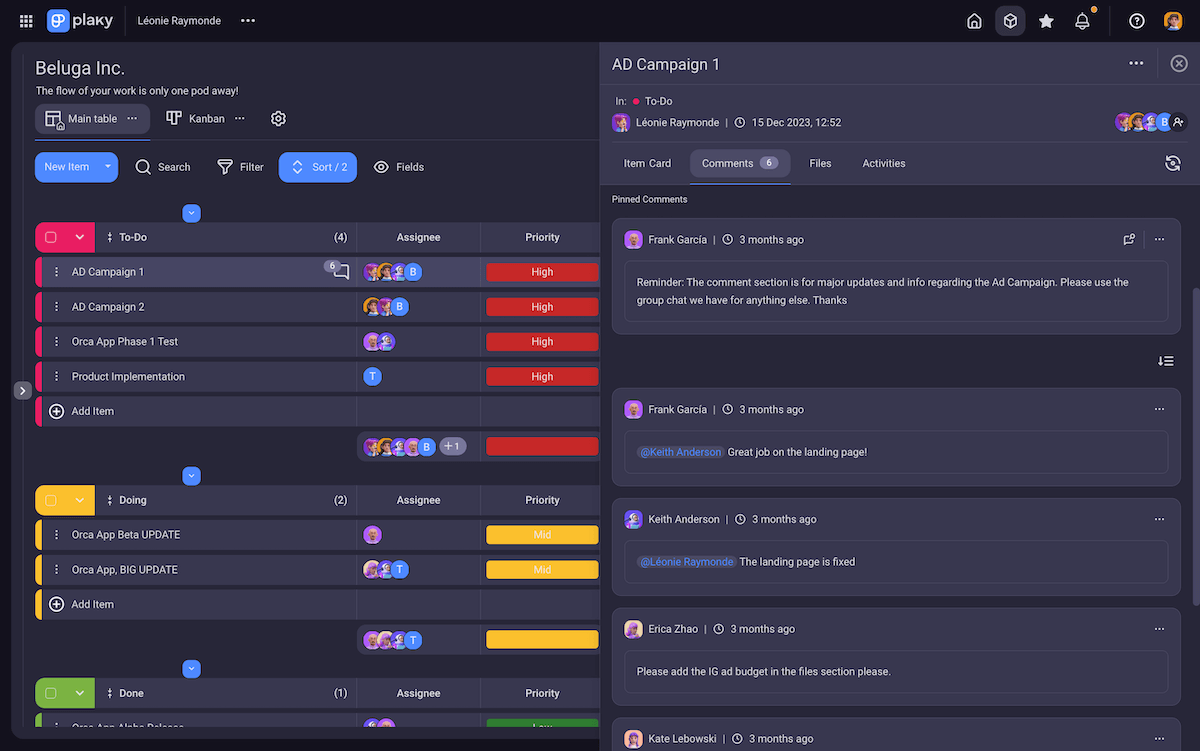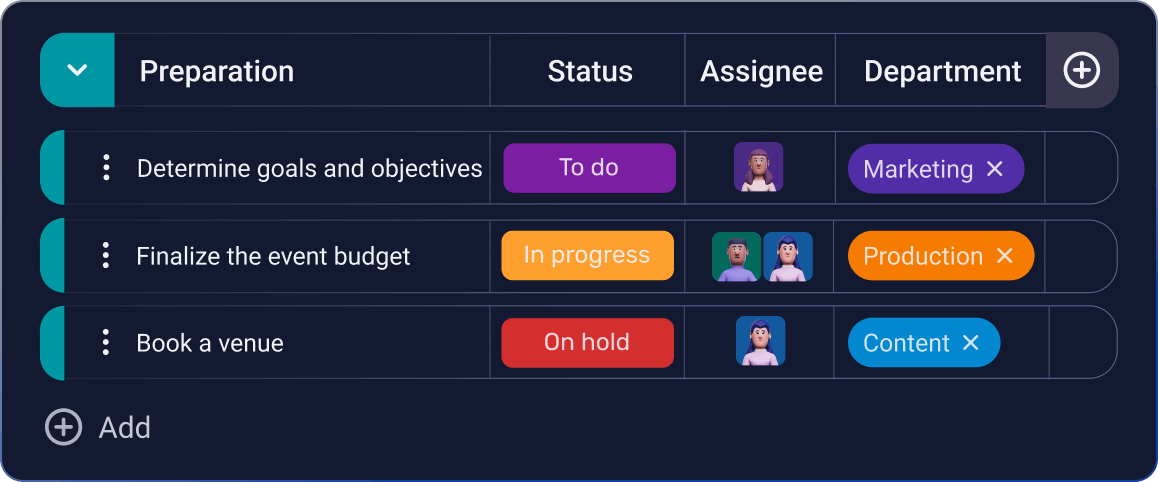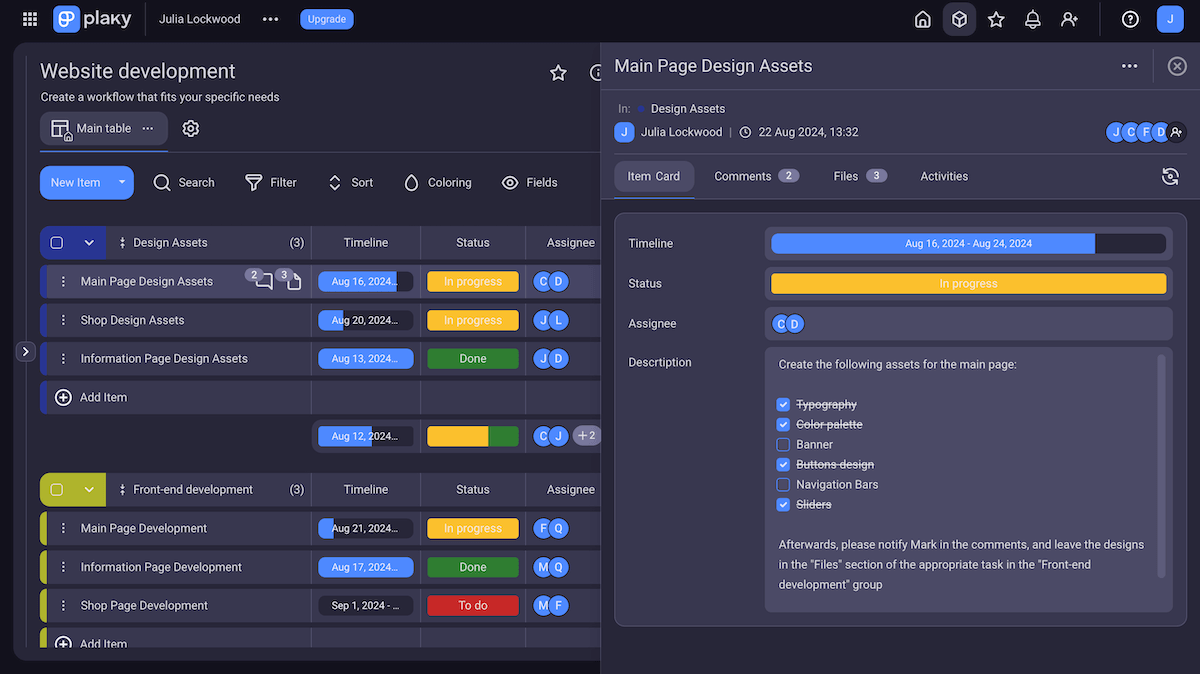Imagine your team is developing an app. But, your teams aren’t really working together.
Your developers are constantly bugging you about when the designs will be ready. On the other hand, the designers keep asking if their designs are compatible with the development schedule. And out of the corner comes marketing, asking if you have any pre-release versions they can use for a campaign.
Maddening, right? It’d be so much easier (for you and the teams) if they just talked to each other.
And that’s exactly it — instead of treating the symptoms, go for the root cause.
All signs point to poor project collaboration. So how can you fix it?
Keep reading to learn about project collaboration, how it positively affects your team, and what experts believe would help improve it.

In this article:
What is project collaboration?
Project collaboration involves the project team working together to better achieve the end goal of a project.
If we break this definition down, we could say that project collaboration is the process of:
- Sharing information,
- Dividing tasks,
- Offering assistance, and
- Actively communicating with other team members on the project.
The goal of project collaboration is to bring the team closer together and get them on the same page about their shared project goals.
Communication is one of the most important aspects of project collaboration. When team communication runs freely and efficiently, everyone’s on the same page about their tasks, shared goals, and how to reach them.
In essence — if you communicate well, you can collaborate well.
Collaborate effortlessly in Plaky
Project collaboration vs. project management
Project management is the responsibility of one individual or group in charge of running the project. In comparison, project collaboration is the obligation of everyone on the project team.
The most basic difference is that while project management is the task of organizing a project and its intricacies, project collaboration focuses on teamwork that’s crucial to propel a project to greater heights.
💡 Plaky Pro Tip
If you want to learn more about project management, check out these resources:
Importance of collaboration in project management
Collaboration is the backbone of a project’s success — without it, your team would quickly fall apart. So why does collaboration make such a difference?
Some of its key benefits include:
- Improved productivity — When your team members communicate successfully, it leads to a better understanding of everyone’s duties. This helps them prioritize tasks to reduce bottlenecks.
- Enhanced creativity — With a collaborative culture, team members will build on each other’s ideas, leading to better solutions. However, with poor collaboration, team members try to outperform each other more often than not, which halts progress and innovation.
- Alignment toward project goals — When team members communicate effectively (with each other, but more importantly, with you) they can understand project goals better. When everyone knows what others are doing, you get a clearer picture of the end result.
- Increased accountability — Building on the previous benefit, a good understanding of shared goals leads to more accountability for them. If collaboration is off, team members don’t feel as responsible for their work, which leads to less-than-ideal results.
- Better-quality outcomes — More communication and collaboration leads to more input into the work done in your project. If you encourage cross-functional collaboration, teams from different departments will learn how to work together to achieve better results. This is bound to produce more innovative, creative, and higher-quality solutions.
But most of all — teams just want to collaborate! Especially remote teams since it helps them feel like they’re part of a collective.
This adds purpose to their work, helping employees feel better and producing better project outcomes.

7 signs your project collaboration needs improvement
Project issues are tricky and can often be misinterpreted or even slip under the radar.
Here, we will take a look at the 7 signs that your project collaboration might be at risk.
#1 Poor information flow
What poor information flow boils down to is a lack of collaborative communication.
If your team members aren’t communicating, they’re not collaborating — meaning your project collaboration needs fixing. As Alexander Weinstein, an experienced CTO and Development Team Lead, puts it:

“When team members don’t communicate effectively, important information can be missed, and tasks can be duplicated, leading to delays and confusion.”
For example, if all your communication is individual, people will share the same information over and over again with different team members. Not only is this frustrating, but it can also lead to missed communication or valuable feedback not being shared with the whole team.
💡 Plaky Pro Tip
If you want to know how to improve your communication as a project manager, check out this guide:
#2 Missed deadlines
As a project manager, whenever your project misses a deadline, the first question you need to ask yourself is — why? More often than not, this can be due to poor project collaboration.
Most of the causes of missed deadlines in projects stem from bad communication. With little to no feedback on their work, team members are more likely to be less motivated and less productive, causing them to miss deadlines.
With a lack of teamwork, individuals might not be aware of the project timeline either, thus leaving work unfinished and deadlines unmet. So essentially, almost all issues concerning miscommunication lead to missed deadlines.
💡 Plaky Pro Tip
For practical tips on how to stay organized at work and never miss deadlines, check out the following blog post:
#3 Rise in a silo mentality
Silo mentality refers to team members working in isolation and neglecting to share information about their work with their colleagues. It can also apply to cross-functional teams, not just individual ones — departments can also neglect to share information with each other.
Alexander brings to our attention the dangers of working in silos:

“When team members work in isolation and don’t collaborate with each other, it can lead to a lack of synergy and a suboptimal outcome.”
Silo mentality also demolishes trust between team members, hindering information sharing and ultimately hurting the project workflow and outcome.

#4 Increased non-constructive workplace conflict
It’s safe to say that, if there is a rise in conflict in your project, something’s not right. Alexander points out how this can be a symptom of poor project collaboration:

“If team members have different ideas or ways of working, it can lead to conflict and tension, which can negatively impact the project outcome.”
For example, team members from different backgrounds can work at different paces, which could make them clash if you don’t accommodate each one.
However, conflict can be good for your project if it is constructive. Only non-constructive conflict is a symptom of poor collaboration. Constructive conflict is actually a show of great project collaboration, as it means that open dialogue is encouraged in the workplace.
#5 Lack of project objective clarity
Clearly, if your team isn’t on the same page regarding project objectives, their communication might not be the greatest.
If you don’t address this, a team member who doesn’t understand what they’re working toward is bound to make accidental mistakes, as well as feel isolated in what they are trying to achieve.
This feeling can lead to a lack of motivation and low morale — and, in turn, lousy project outcomes.
The best way to combat this is to create a team charter — outlining the team’s goals, roles, and teamwork expectations for the project.
Set clear objectives and tasks in Plaky
#6 Lack of trust
Team members can stop believing in each other due to poor collaboration. You have to pay extra attention to notice this — it’s much subtler than conflict.
As Leigh Ann Gunther (PMP, PMI-ACP), Senior Technical Project Manager with over 15 years of project management experience, puts it:

“This can come in many different ways – people may not trust that their team members will meet deadlines, work to the best of their ability, etc. By bringing people together, any roadblocks or inconsistencies in priorities can be brought to the table. I would encourage project managers to address mistrust as quickly as possible – even during Sprints if appropriate.”
The tricky thing about mistrust is that it festers easily, creating a bias that is difficult to get rid of.
This is why Leigh Ann advises mistrust to be treated immediately — before it can sink its roots into your team’s mindset.
#7 Lack of constructive conflict
While conflict can be harmful, not allowing for constructive conflict can be just as bad. Leigh Ann points to the importance of creating an environment where everyone can speak their minds:

“If your team members are hesitant to challenge the status quo due to not wanting to make ripples across the team, change is needed. Normalizing conflict – normalizing debates and discussions – is a critical component of collaboration. Project managers must create an environment where hiccups are OK, and (healthy) debates to settle them are encouraged.”

6 tips for collaborative project management
We’ve explained how to notice something is off in project collaboration, but how do you address it?
Read on to get expert tips on how to improve your project collaboration once and for all!
#1 Improve your information flow
Our first tip comes from Donna Franklin West (PMP), a project manager with over 14 years of experience, who suggests that you can make information more accessible to your team through several methods:

“To improve project collaboration, I have found that regular check-ins, clear communication channels, and a focus on shared goals and objectives can make a significant difference.”
Good information flow also gets everyone on the same page. Team activities — like brainstorming sessions — raise awareness of project goals, make the team feel like they’re part of a bigger picture, and let them pick up work tips from others.
Be careful, though — too much information can be a strain and even distract team members from their tasks or drain their energy.
Streamline information sharing in Plaky
#2 Use project collaboration tools
PM tools can do wonders for your project collaboration, as Donna has pointed out:

“Using collaboration tools like shared documents, project management software, and communication platforms can help facilitate collaboration and keep everyone on track.”
Make sure to pick team collaboration software like Plaky that facilitates collaborative projects.
In the last tip, we mentioned that too much information can be a bother to your team. Using a PM tool can ease this pressure, as most back-and-forth communication can be reduced to a couple of comments and mentions in a task card.
What’s more, task progress, and therefore the project’s performance, is easily trackable in a PM tool— and available to everyone in your team.

#3 Set clear expectations
It’s important to communicate expectations accurately when giving team members their tasks. You should also make sure that the task order doesn’t prevent collaboration.
As Alexander puts it: all tasks need to be clear in roles and responsibilities:

“I ensure that each team member knows what they are responsible for and establish clear expectations for everyone’s role on the team.”
Setting expectations is also important to avoid team members going below, but also above them.
Collaboration tools serve greatly in this regard too, as they can be used to set clear tasks that are easy to find and interpret.


#4 Create an open work environment
Donna suggests that to make a step in the right direction for your project collaboration, you need to work on your work environment:

“A culture where everyone’s input is valued, and team members feel comfortable sharing their ideas and concerns is key.”
A project where the only valued input comes from managers is doomed to fail — after all, the team is doing the actual work, so they know more about that process. Their input is nothing but beneficial.
Similarly, if your team feels excluded from the project, they won’t feel responsible or motivated to work on it.
#5 Celebrate your wins
Experienced marketing lead, Rugilė Žukauskaitė-Žilinskė, also reminded us that it’s important to take time to acknowledge great work:

“Celebrate milestones and achievements to keep team morale high. It’s crucial to celebrate the wins! It’s the best motivation.”
Whether it’s a shout-out during your team meeting, a party, or just a message of acknowledgement in your team chat app, your team will appreciate it.
Above all, celebrating wins can:
- Boost morale for upcoming tasks,
- Create a greater sense of unity,
- Reduce workplace stress and conflict, and
- Create a sense of responsibility in your team.
#6 Be adaptable and experiment
Finally, Leigh Ann points out why it’s important to be adaptable:

“Everyone wants to collaborate in their own way, and successful collaboration may look different between teams. The first step to improving your project collaboration is to understand how your team members want to collaborate.”
As Leigh Ann adds, leaders shouldn’t hesitate to make changes, but they must create an environment where change is just a normal part of the job:

“For those who may feel that their status quo could use some upgrading, I would encourage them to experiment with more agile ways of working. These pivots can be on how you are executing your project, but they can also be on how you are collaborating with your teams.”
Improve project collaboration with Plaky
Since collaboration is such a key element of any project, it’s important to choose the right tool for it.
Plaky intuitively encourages communication and collaboration — as your team gets used to using it, they’ll find themselves collaborating more effectively.
While working on their tasks in Plaky, team members can:
- Send and reply to comments — Eliminate confusion by communicating in item-specific comments, and use @mentions to tag and notify any relevant team members.
- Share files — Item-specific file sharing ensures that all information is organized and available to all team members. This way, you can cut unnecessary communication, while teams still have access to much-needed info.
- Get notified of all changes — Receive notifications about any new assignments, updates, or mentions, and make sure everyone is aware of all information shared with them.

However, just notifying team members about their own tasks can create silos — this is why, in Plaky, teams can easily check out the progress of the whole project.
The activity log lets your team see any changes made within a single board or item, which should minimize mistakes falling through the cracks.
At the same time, switching to the Gantt chart view allows them to keep an eye on the project timeline, improve their task planning, and avoid bottlenecks.

On top of that, Plaky improves goal clarity. With clearly outlined tasks that the whole team can see, everyone will know what others are working on.
So what does this mean for your team?
No more unnecessary, inefficient communication. No more lost/missed information, or never knowing what anyone else in the team is up to.
With Plaky, no matter where your team is, collaboration will be at their fingertips.
Whether team members work remotely or not, you don’t want them to work alone. Make them a part of a collaborative team with Plaky — sign up for a free account today.
